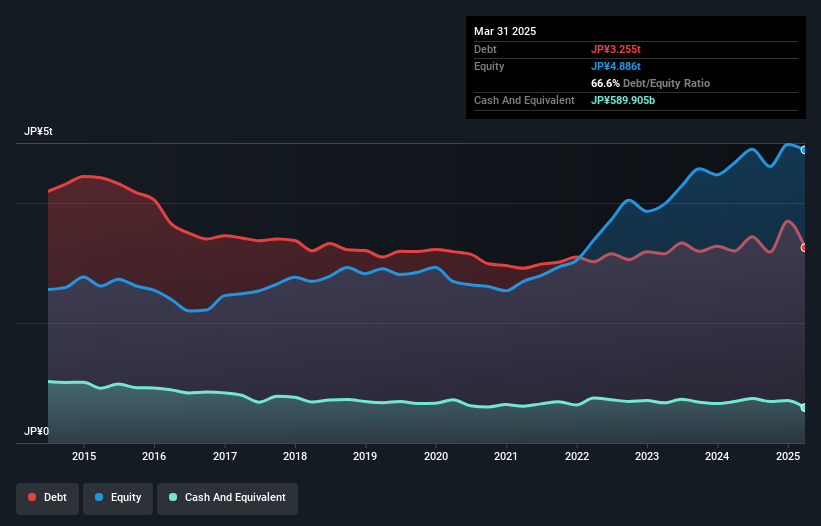
Howard Marks put it nicely when he said that, rather than worrying about share price volatility, 'The possibility of permanent loss is the risk I worry about... and every practical investor I know worries about.' It's only natural to consider a company's balance sheet when you examine how risky it is, since debt is often involved when a business collapses. We note that Sumitomo Corporation (TSE:8053) does have debt on its balance sheet. But the more important question is: how much risk is that debt creating?
We've discovered 2 warning signs about Sumitomo. View them for free.Why Does Debt Bring Risk?
Generally speaking, debt only becomes a real problem when a company can't easily pay it off, either by raising capital or with its own cash flow. Ultimately, if the company can't fulfill its legal obligations to repay debt, shareholders could walk away with nothing. While that is not too common, we often do see indebted companies permanently diluting shareholders because lenders force them to raise capital at a distressed price. Of course, plenty of companies use debt to fund growth, without any negative consequences. The first step when considering a company's debt levels is to consider its cash and debt together.
How Much Debt Does Sumitomo Carry?
The chart below, which you can click on for greater detail, shows that Sumitomo had JP¥3.25t in debt in March 2025; about the same as the year before. On the flip side, it has JP¥589.9b in cash leading to net debt of about JP¥2.66t.

How Healthy Is Sumitomo's Balance Sheet?
Zooming in on the latest balance sheet data, we can see that Sumitomo had liabilities of JP¥3.26t due within 12 months and liabilities of JP¥3.48t due beyond that. Offsetting this, it had JP¥589.9b in cash and JP¥2.05t in receivables that were due within 12 months. So its liabilities outweigh the sum of its cash and (near-term) receivables by JP¥4.10t.
This is a mountain of leverage even relative to its gargantuan market capitalization of JP¥4.44t. This suggests shareholders would be heavily diluted if the company needed to shore up its balance sheet in a hurry.
View our latest analysis for Sumitomo
We use two main ratios to inform us about debt levels relative to earnings. The first is net debt divided by earnings before interest, tax, depreciation, and amortization (EBITDA), while the second is how many times its earnings before interest and tax (EBIT) covers its interest expense (or its interest cover, for short). This way, we consider both the absolute quantum of the debt, as well as the interest rates paid on it.
Sumitomo's net debt is 4.3 times its EBITDA, which is a significant but still reasonable amount of leverage. However, its interest coverage of 32.9 is very high, suggesting that the interest expense on the debt is currently quite low. Sadly, Sumitomo's EBIT actually dropped 2.4% in the last year. If that earnings trend continues then its debt load will grow heavy like the heart of a polar bear watching its sole cub. When analysing debt levels, the balance sheet is the obvious place to start. But ultimately the future profitability of the business will decide if Sumitomo can strengthen its balance sheet over time. So if you want to see what the professionals think, you might find this free report on analyst profit forecasts to be interesting.
Finally, a business needs free cash flow to pay off debt; accounting profits just don't cut it. So it's worth checking how much of that EBIT is backed by free cash flow. Over the last three years, Sumitomo recorded free cash flow worth a fulsome 96% of its EBIT, which is stronger than we'd usually expect. That positions it well to pay down debt if desirable to do so.
Our View
Sumitomo's interest cover was a real positive on this analysis, as was its conversion of EBIT to free cash flow. Having said that, its net debt to EBITDA somewhat sensitizes us to potential future risks to the balance sheet. Looking at all this data makes us feel a little cautious about Sumitomo's debt levels. While we appreciate debt can enhance returns on equity, we'd suggest that shareholders keep close watch on its debt levels, lest they increase. The balance sheet is clearly the area to focus on when you are analysing debt. However, not all investment risk resides within the balance sheet - far from it. For example Sumitomo has 2 warning signs (and 1 which shouldn't be ignored) we think you should know about.
At the end of the day, it's often better to focus on companies that are free from net debt. You can access our special list of such companies (all with a track record of profit growth). It's free.
New: Manage All Your Stock Portfolios in One Place
We've created the ultimate portfolio companion for stock investors, and it's free.
• Connect an unlimited number of Portfolios and see your total in one currency
• Be alerted to new Warning Signs or Risks via email or mobile
• Track the Fair Value of your stocks
Have feedback on this article? Concerned about the content? Get in touch with us directly. Alternatively, email editorial-team (at) simplywallst.com.
This article by Simply Wall St is general in nature. We provide commentary based on historical data and analyst forecasts only using an unbiased methodology and our articles are not intended to be financial advice. It does not constitute a recommendation to buy or sell any stock, and does not take account of your objectives, or your financial situation. We aim to bring you long-term focused analysis driven by fundamental data. Note that our analysis may not factor in the latest price-sensitive company announcements or qualitative material. Simply Wall St has no position in any stocks mentioned.
About TSE:8053
Solid track record, good value and pays a dividend.
Similar Companies
Market Insights
Community Narratives




